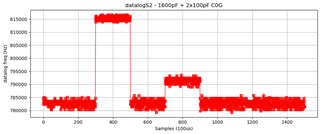Tool/software:
Hello community,
in my application I have a board that embeds LDC1101 following the layout and guidelines of the dedicated Evaluation Module (LDC1101EVM).
The board is connected via twisted cable (length=2.5 cm) to a planar inductance of 23 uH (measured) and a capacitor section .
The capacitor section is made up by three capacitor footprints in parallel (for calibration purpose).
The sensor is a 6 cm x 6 cm inductor with track width of 0.5 mm and 1 mm (center-center) of spacing (0.5 mm effective).
Now, I experienced the following cases:
- The planar inductor with a capacitor of 1200pF C0G and 2 empty footprints is quite noisy but works (datalog S1 freq (Hz) in the figure below).
- The planar inductor with a capacitor of 1800pF C0G and 2 empty footprints is quite noisy and in general works but I register several big spikes (see datalog S2 freq (Hz) in the figure below).

More information:
The same inductor with no calibration footprints works quite good (reduced variance and no spikes).
The planar inductor with a capacitor of 1800pF C0G and 2 empty footprints is quite noisy but works (no spikes) when a metal target is present.
Can someone help me with it?
Thanks a lot,
Giovanni


